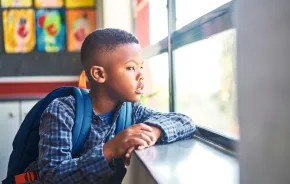 Over the summer, Edmonds, Wash. school district administrators generated a heated discussion when they proposed a policy change that would allow individual schools to consider requiring students to wear uniforms. Although none of the district’s schools currently plan on adopting a uniform policy, the very mention of the topic ignited a firestorm of debate among local parents.
Over the summer, Edmonds, Wash. school district administrators generated a heated discussion when they proposed a policy change that would allow individual schools to consider requiring students to wear uniforms. Although none of the district’s schools currently plan on adopting a uniform policy, the very mention of the topic ignited a firestorm of debate among local parents.
In 1994, Long Beach Unified School District in California made national news by becoming the first major public school district to adopt a uniform policy. According to the U.S. Department of Education, after the policy went into effect, school crime in the district fell 36 percent, fights between students fell 51 percent, and sexual offenses fell 74 percent.
Now, nearly two decades later, 19 percent of public schools across the country require uniforms, while 57 percent enforce a strict dress code. In Washington, each of the state’s 295 districts set their own policies.
According to the Puget Sound Educational Service District, there are several schools within local districts — including Seattle Public Schools, Federal Way Public Schools, Highline School District, Kent School District and Tacoma Public Schools — that have adopted uniform policies. Uniforms are also common at many private schools.
Freedom to focus
The school uniform idea has its share of supporters, who claim there are countless advantages to requiring them in schools.
Angela Sheffey Bogan, principal at Dearborn Park Elementary on Beacon Hill in Seattle, where a uniform policy is in place, says she surveys her parents every spring on whether they would like to see uniforms remain. “Overwhelmingly, year after year, parents want to see it continue,” she says. “They love it for many reasons.”
Those who like uniforms say they reduce classroom distractions by eliminating the attention kids pay to skimpy clothing, designer brands and gang colors. They also contend that dressing in a professional manner at a young age instills a sense of pride and responsibility — and sets kids up with a mental attitude that will enhance learning. That thinking is spot-on, according to Bogan. “Wearing a uniform gives the student a sense of pride. I see such a difference in kids’ attitudes when they don’t have them on.”
What else do parents and teachers mention? There’s less bullying over the way someone’s dressed; attendance is better; morning routines are simpler; and there’s less financial pressure on families, who don’t have to worry about springing for costly back-to-school wardrobes. School security even gets a boost: Visitors (and intruders) can be spotted more easily. And here’s another plus: When everyone dresses alike, no one is wearing designer duds — or anything else that’s out-of-reach expensive or outrageously trendy.
Ann Kendall, whose daughter, Elsa, wears a uniform at Hope Lutheran in West Seattle, supports the school’s uniform policy. “I think it’s very positive; it’s about showing respect for the learning environment. You’re there to focus on your studies, not fashion.”
Typically, a school’s uniform policy has a bit of flexibility built in — there are a number of choices that are approved to build a consistent look among the student body. For instance, a popular combination of uniform pieces might be a polo shirt, khaki or navy pants; a jumper or skirt for girls; and a cardigan option. Often, the color could be any one of three — a polo shirt in navy, white or gray, for example — and the brand isn’t specified. “At our school, they might recommend Lands’ End, but Target khakis work just as well,” says Kendall.
Although research on the impact of school uniforms is minimal, a recent University of Nevada study (which focused on two middle schools in the Reno area) found there was a 63 percent decrease in police reports at one school in the first year uniforms were required.
Free to be different?
Those who dislike dress codes, however, paint a different picture. They argue that forcing students to wear uniforms squelches kids’ freedom of expression and ability to be creative — that uniforms highlight conformity, not individuality.
Barbara C. Cruz, Ph.D., a University of South Florida professor and author of School Dress Codes: A Pro/Con Issue, points out, “We each have an external persona, and that is manifested through what we wear or how we wear our hair. And adolescence is a time of self-exploration, self-discovery, identity development — kids are testing out who they want to be.”
Yet, of the 1,350 seventh- and eighth-graders surveyed in the Reno study, 54 percent said they felt they retained their individuality, even when they wore a uniform to school.
Kendall agrees. “They can wear whatever shoes they want, whatever headband or hair accessory they want. It’s not like they are all little cookie cutters. They’re just wearing similar clothes at school. And you can wear whatever you want after school — throw on a tank top or sundress or whatever, but that’s not what we wear at school.”
Uniforms, says Cruz, seem to “make sense for some schools in certain situations.” Acknowledging the pros and cons and differences in opinion, Bogan concedes, “It depends on the community. But if the community supports [a uniform policy], it can be a very, very good thing for local schools.”
Andrea Dashiell is a freelance writer whose work has been published in Seattle Magazine, The Seattle Times, DailyCandy Kids, Red Tricycle and on Parents.com.









